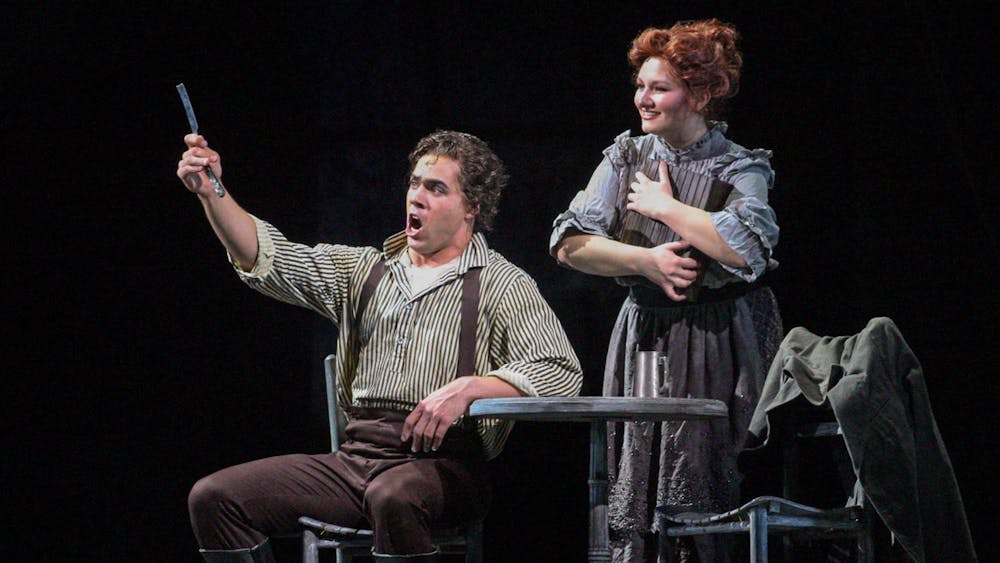A girl kisses her beau on a city street outside a Paris café; a young movie star shares a moment with the camera on her first movie set; and a famous photographer contemplates his work from inside a New York gallery. All these scenes have found their ways into the select collection of photography now on display at the IU Art Museum.\n"This collection is Thomas Solley's own collected artwork ... This exhibition is just a small means of highlighting a certain selection," said Nan Brewer, the IU Art Museum's curator of works on paper. "We narrowed it down to 56 of 4,500 pieces, and decided to focus on two major cultural centers, New York and Paris."\nAlthough the collection does contain pieces that deviate from this overarching theme, many of the photographs are focused on subjects that have become part of the fabric of the two cities. The photographs feature architectural marvels, such as the Flatiron Building in New York, or subjects that are more personal, such as city goers in Paris.\nThe collection is titled "Cosmopolitan: New York and Paris." Society has often defined "cosmopolitan" in terms of the basic makeup of any city, but in this collection the museum attempted to take a more in-depth look at the meaning of this word.\n"(The works feature) New York's energy and vitality, and Paris' mystery and old-world charm," Brewer said. "(Solley's) collection of photography reflects his eye for elegant, sophisticated images with an emotional or historical resonance."\nSome of the works are more abstract in flavor, such as the avant-garde photo "Dovima with Elephants, Evening Dress" by Richard Avedon. This photo features a highly sophisticated and fashionable woman framed by two large elephants in a model's pose. The juxtaposition of the woman's typical model's pose is contrasted with the strange elephants that surround her.\nOn the opposite end of the societal spectrum, the photo titled "Children, Ambervillers," finds its way into the same collection. The subject is neither avant-garde nor highly sophisticated. It shows the angelic faces of two young street children peeking out at the viewer from their back-ally street surroundings. They are sullen, yet their wispily smiling faces belie the dismally sad and expansive background of which they are a part. \nAnother photograph, titled "Champ-de-Mars, from the Eiffel Tower, Paris," by Ilse Bing, allows the viewer to gaze at the city scene below through the grates of the Eiffel Tower. The figures on the street are like far-away walking black blurs. \nThese are just a few of the subjects this diverse collection showcases. The subjects of the photographs include the elite and the unfortunate, the sophisticated and the displaced, the beautiful and the archetypal city architecture, and those people who seem to belong as well as those who don't.\nBrewer said much of the allure of the works is that they are non-touristy: They feature places, such as a quaint back road, that you would normally see. Yet, in some cases, the interesting aspect of the photo lies in the technique of the photographer. \n"Toward the back corner, some of the black photos, where there is double exposure involved, it is interesting to see the creative process of the photographer," said senior visual arts education major Daniel Zapata.\nFor other viewers, the human form is the appeal of many of the photographs. \n"The composition of some of the photographs, such as the abstraction of the nude, where there is juxtaposition of light and dark, can make the figure seem abstract, even though it is a literal form," said Brian Garvey, a graphic designer and employee of the IUAM.\nThe sense of the city is felt through all of the collection, while many of the photographs rely on the appeal of the city subject to display a message or convey a thought of the photographer. For decades, society has defined and redefined what it believes to be the true meaning of the word "cosmopolitan." This collection shows the many facets of that idea through its variety of artwork. \n-- Contact staff writer Olivia Morales at ormorale@indiana.edu.
'Cosmopolitan' captures New York, Paris
Get stories like this in your inbox
Subscribe





